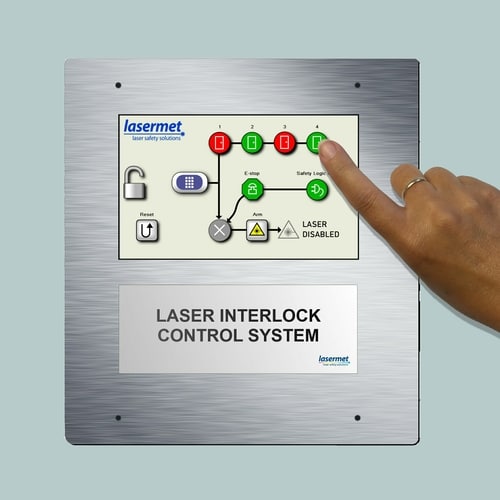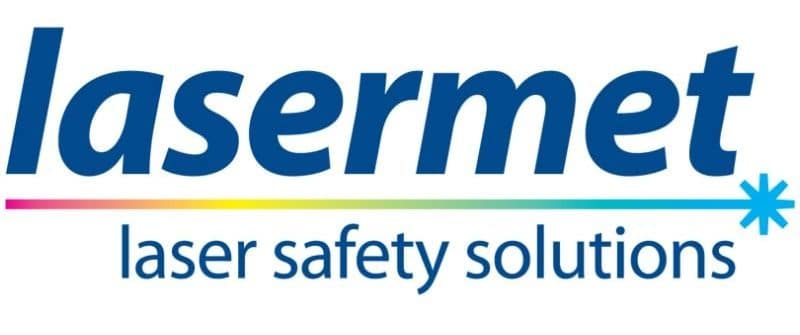Laser Interlock Systems for Operating Rooms
Lasermet has a long history in the field of laser interlocks, having manufactured and installed these systems since 1996. Our industry-leading ICS series of Laser Interlock® Controllers has been installed in thousands of locations throughout the United Kingdom and beyond.
When installing in operating rooms, a configuration designed specifically to meet the needs of surgeons and other theater personnel is used. This is known as a ‘locking Interlock® system’. The system will automatically switch the illuminated laser warning signs while performing Interlock® functions.
Lasermet can and will provide complete turnkey laser safety solutions to meet any requirement or configuration.
Requirement for Interlocks
The Department of Health document ‘DB2008: Guidance on the safe use of lasers, intense light source systems, and LEDs in medical, surgical, dental, and aesthetic practices’ states that (within the hierarchy for controlling safety under the heading of Equipment/Engineering), control measures will include device interlocks, room interlocks, warning lights, barriers, and laser-proof blinds, among other things.
The Controlled Area includes the region where the MPE is exceeded and requires specific protective control measures. This is true for many, if not most, lasers used in operating rooms.
Furthermore, the Laser Safety User Guide (IEC TR 60825-14 ‘Safety of Laser Products, Part 14: A Users Guide) adopted by the UK states that interlocks should be used for all Class 3B and Class 4 lasers unless a risk assessment shows that they are not necessary.
Laser Protection
Interlocks have traditionally been unpopular in hospitals because they can disable the laser when the surgeon wants to use it. Lasermet addressed this issue by developing a laser Interlock® system that both protects the staff and the operation’s integrity by preventing laser interruptions. This is accomplished by installing maglocks on the doors, which are activated whenever the laser is turned on, preventing accidental door opening.
Authorized override via keypad code allows suitably prepared staff to enter or exit the theatre without disrupting the laser. This system has been installed in many operating rooms, allowing lasers to be used indefinitely and without endangering staff.
The Lasermet Solution

The ICS-TOUCH Interlock® Controller is the ideal solution for Interlock® control in operating rooms.
The ICS-TOUCH offers touchscreen monitoring and control for operating rooms and X-ray machines, with simple touchscreen technology capable of monitoring and controlling interlocked doors, roller blinds, emergency stops, and a secure keypad access point.
It also meets all ISO 13849-1 Performance Level ‘e’ (PL ‘e’) safety requirements for full dual channel safety.
Laser Safety in Hospital Theaters
Lasermet has long addressed the need for laser safety systems and laser safety equipment in hospital operating rooms to meet relevant laser safety standards and hospital requirements. The safety of patients, staff, and other personnel is of the highest priority, and this has been formalized in the following guidance documents.
In the United Kingdom, two relevant guidance documents are HBN26 (issued by NHS Estates) and DB2008 (issued by the MHRA).
The MHRA is an executive agency of the Department of Health in charge of the regulation of medicines, medical devices, and healthcare equipment, as well as the investigation of harmful incidents. It makes use of the following document:
DB2008 (03) Device Bulletin
Guidance on the safe use of lasers, intense light source systems and LEDs in medical, surgical, dental and aesthetic practices
The document is intended for anyone involved in the purchase, supply, installation, use, and maintenance of medical, dental, and cosmetic lasers, IPL systems, and LEDs. The first part of Section 5.1 of DB2008 (03) deals with safety mechanisms and hazard control.
HIERARCHY FOR CONTROLLING SAFETY
- equipment/engineering
- administration
- personal
Prior to implementing personal protective measures, equipment/engineering and administration safety control measures should be established to reduce risk.
EQUIPMENT / ENGINEERING
Device interlocks, room interlocks (if appropriate), warning lights, barriers, and laser-proof blinds are examples of control measures.
A ‘Controlled Area’ for a laser is the area around the laser where people may be present and specific protective control measures are required. The region around the equipment where the maximum permissible exposure (MPE) level is exceeded should be included in the Controlled Area. MPE refers to the highest level of laser exposure at the eye or skin that is generally considered safe.
If the level of direct, reflected, or scattered optical radiation achieved within the equipment area during normal operation exceeds the applicable MPE, the area will be subject to control and supervision for radiation protection.
CONTROLLING ACCESS
When the laser or IPL is in use, a variety of methods can be used to control access. The mechanism best suited to a given environment should be used. The following are examples:
- knock and wait to be admitted
- key pad lock
- interlocks (door or equipment)
HBN26 Facilities for Surgical Procedures – NHS Estates
This document is described as Guidance on facilities for in-patient operating theaters in acute general hospitals by NHS Estates, and its purpose is Best Practice Guidance. The following are relevant excerpts from this document…
DOOR COVERS
4.79 Doors within the operating suite all doors should be fitted with vision panels capable of being obscured, and have laser proof blinds…
THEATRE WARNING LIGHT
4.91 Each theater requires a light warning when laser surgery and X-rays are being undertaken. The lights should be located in the corridor above the theater doors…
USE OF LASERS IN THE OPERATING THEATRE
7.120 When lasers are used in an operating theater, safety precautions in accordance with BS EN 60825 should be taken, including the installation of warning lamps at the theater’s entrances and door interlocks that prevent entry when the laser is in use…
Lasermet’s laser safety systems meet all the requirements of these documents and the relevant laser safety standards.

